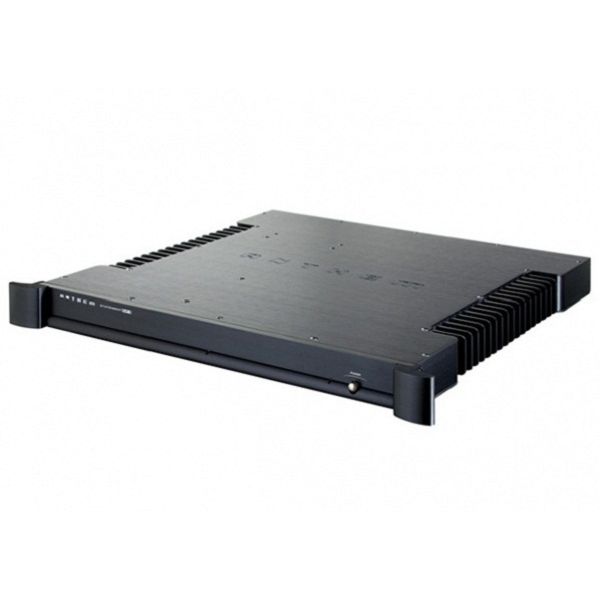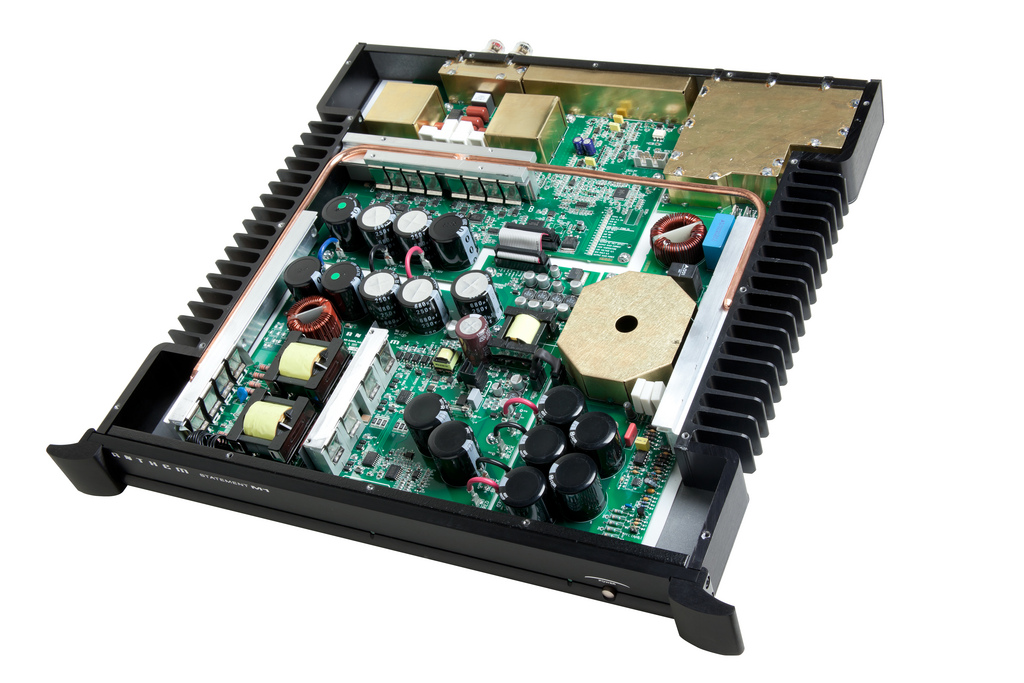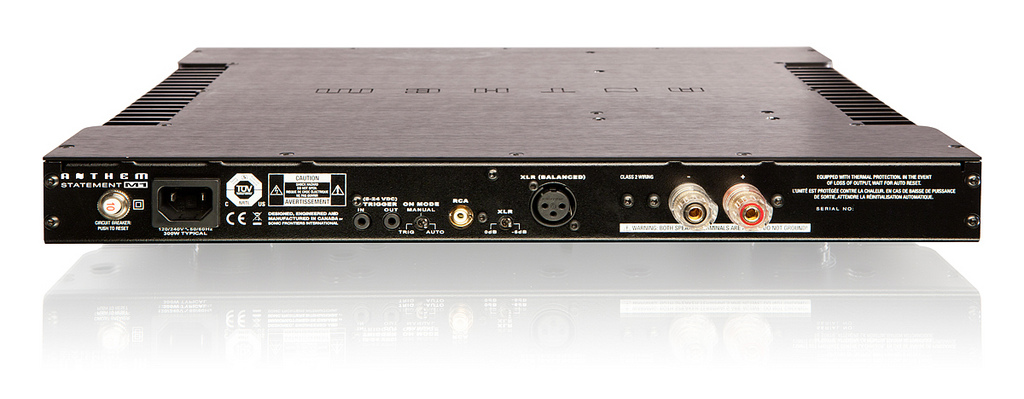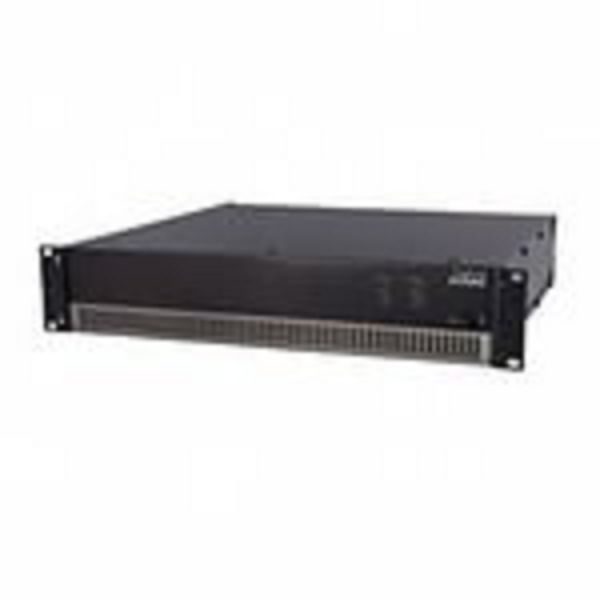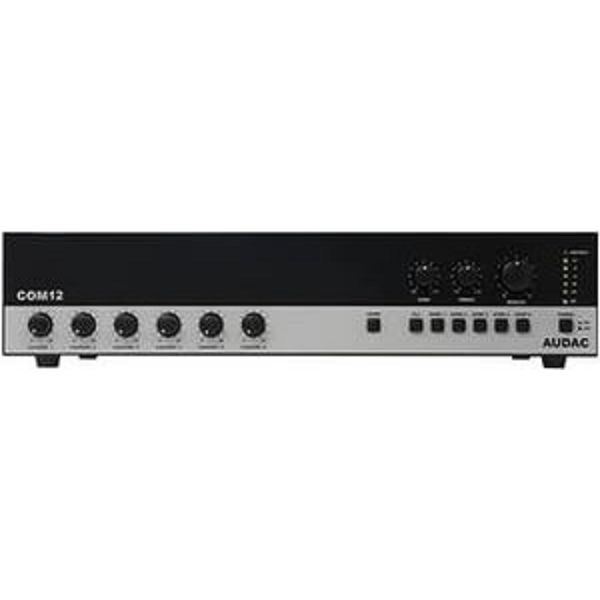
Новаторский моноблок Anthem Statement M 1 доказывает то, что потенциал усилителей D-класса отнюдь не исчерпан. Модель обладает плоским корпусом высотой в 6 см, так как использует компактный, но эффективный импульсный блок питания. Передняя панель оснащена боковыми ручками для монтажа в рэковую стойку. В центре фасада имеется индикатор включения в сеть. Справа находится кнопка питания и светодиод, который имеет ровное свечение в обычном режиме и мерцает при появлении каких-либо проблем.
Теплоотводы встроены в боковины усилителя и являются частью пассивной системы охлаждения, включающей в себя прикрепленные к ним герметичные медные вакуумные трубки, в которых находится некоторое количество жидкости. Процесс охлаждения происходит при ее испарении в результате нагрева, затем влага конденсируется и все повторяется снова. Поэтому M 1 не нуждается в кулерах и работает бесшумно.
Специальный импульсный блок питания (ИБП) обеспечивает эффективную стабилизацию напряжения и обладает высоким КПД. Он связан с системой Power Factor Correction (PFC), которая позволяет значительно увеличить выходную мощность и в то же время существенно понизить уровень шумов. Работа ИБП в паре с PFC дает возможность получить чистые синусоиды напряжения и тока, находящиеся в одинаковой фазе. В итоге усилитель выдает внушительные 1000 Вт при 8 Ом, 2 кВт при 4 Ом и 2,4 кВт (3 Ом)! В выходном каскаде установлены восемь быстродействующих MOSFET-транзисторов. Модель работает в мостовом режиме.
Входы: разъем RCA и балансный XLR с переключателем, понижающим уровень сигнала на 6 дБ. Для акустики имеется пара винтовых клемм. Есть триггерный вход и выход, а также тумблер выбора режима управления включением (триггерный, ручной или Auto). В режиме Auto усилитель активируется автоматически при появлении сигнала…
Характеристики
Название ANTHEM Statement M 1
Производитель ANTHEM (Канада)
Серия M Series
Тип устройства Усилитель мощности
Цвет Черный (Black)
Габариты, мм 490 х 57 х 476
Вес, кг 9
Гарантия 12 месяцев
Основные характеристики
Количество каналов 1 (моно)
Мощность 8 Ом, Вт 1 х 1000
Мощность 4 Ом, Вт 1 х 2000
Частотный диапазон, Гц-кГц 20 – 20
Соотношение с/ш, дБ 113
Коэффициент гармоник, % 0,01
Соединительные разъемы вход
Аналоговые аудио 1 х RCA, 1 х XLR
Другие 1 x 3,5 мм триггер
Соединительные разъемы выход
Акустические 1 пара
Другие 1 x 3,5 мм триггер
Обзор/Тест
When I first saw Anthem Statement’s M1 at the 2011 CEDIA Expo, it was a bolt from the blue. Happening on this flat, black slab of an amplifier lying on a display table or bolted to a wall, reminded me of the appearance of the iconic monolith in Stanley Kubrick and Arthur C. Clarke’s 2001: A Space Odyssey. The M1’s dimensional ratios are not 12:22:32, and there are many other one-rack-unit amps—yet, like the monolith on the moon, the M1 was in such striking contrast to everything else in its environment that it demanded attention and reflection.
I soon learned that the M1 is a 1000W or 2000W (into 8 or 4 ohms) monoblock amplifier that costs $3499 each, $6998/pair. Of course, Anthem flowered from the ashes of Sonic Frontiers and continues to produce high-quality amplifiers, although today their image (if not their substance) is associated more with home-theater components than with the (mostly) tubed high-end audio gear Sonic Frontiers made. Indeed, this is the first single-channel amplifier to bear the Anthem logo—and it’s class-D to boot.
Class-D amplifiers are to the High End what electric cars are to the auto industry. Everyone acknowledges the advantages of the technology in terms of efficiency and ecological benevolence, but so far, neither has captured the souls of aficionados who demand cutting-edge sound regardless of the cost, whether in dollars or degrees. Anthem claims that the M1 is on that cutting edge. First, the ratio of the M1’s power output to its size and weight is remarkable, as are its claimed distortion and noise specs. Second, in addition to the well-known efficiency of class-D circuitry, the M1 has an internal heat-pipe cooling system that allows multiple M1s to be stacked without the need for fans or bristling arrays of heatsink fins. Third, in contrast to most other class-D amps, which are based on a handful of commercially available core circuits or already populated circuit boards, Anthem claims to have created the M1 entirely in-house.
The M1 has a bridge-mode configuration using MOSFET power transistors, which means that its output is balanced, isolated from ground, and has lower ripple because it effectively doubles the supply ripple frequency and halves its voltage. The M1’s power supply operates at 0.4MHz (400kHz), which is, consequently, its native pulse frequency. That frequency is directly modulated by the analog signal with a theoretically infinite time resolution. The resulting pulse-density (not pulse-width) modulated output is claimed to achieve a practical time resolution of 4 nanoseconds (0.000000004s), which is more than an order of magnitude better than that of the DSD coding used on SACD.
Pizza Delivery!
The M1’s appearance and heritage, and the prospect of nearly limitless power, made the wait for its delivery seem, as when one orders out for dinner, much longer than it was. Anthem was generous in sending me three M1s so that, during the course of my listening for this review—which is essentially of the M1’s performance with two-channel recordings—I could also enjoy some multichannel listening: the front left, center, and right channels would have identical amplification.
Each M1 arrived in what looked like an outsized pizza box 2′ square and 6″ thick, suitable for the very largest, deep-dish, meat-lovers’ pies. Inside, the M1 sat in a nest of firm foam, and was accompanied by an operating manual, a pair of rack-mount handles, and two power cords. One cord is a three-pronged 20A/240V cable, the other a two-pronged 15A/120V cable, with a two-conductor IEC connection at the amp end. I used the latter; I have only 15A lines in my apartment.
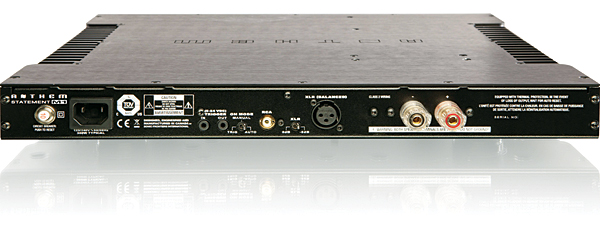
The manual indicates that the M1’s continuous high-power output depends on the power supply, but offers a single set of specs without regard for the AC input. Anthem says that the M1 has power-factor correction, which ensures that voltage and current drawn from the wall are in-phase. A load-monitoring system, based on “a digitally modeled time constant of the circuit interruptor,” allows large current surges that aren’t long enough to result in excessive heat. As a result, while the M1 can put out 2kW continuously into 4 ohms when fed by 240V mains, it can still put out 2kW for the duration of typical musical peaks when fed by a dedicated 120V 15A line, without causing circuit interruption. I asked Anthem how best to set up three M1s with my two 15A lines. Surprisingly, they suggested that I plug them all into one line, but that if I used only two M1s, to plug each into its own line. I ran the M1s both ways and could hear no differences.
Setup was uneventful. After plugging the interconnects into the XLR inputs and attaching the speaker cables, I left each M1’s gain-attenuation switch at 0dB to match the gain of my other amps, and set the M1s’ On mode to Auto so that the amps would turn themselves on when they sensed the presence of a signal. Auto mode worked flawlessly when the M1s were directly connected to my Meridian 861 Reference v6 digital surround controller, but was sometimes spuriously triggered when connected via the DSPeaker Anti-Mode 2.0 room correction unit (see “Music in the Round,” November 2012), which suggests that the latter is not as impervious to line noise as the Meridian.
The M1’s front panel has only a power button and two LEDs. The power LED illuminates during normal operation; the status LED signals codes that indicate different problems with power or temperature, but remains steadily illuminated during normal operation. Both LEDs glow blue, and were either on or off throughout my listening, as no problems arose. With the three M1s neatly stacked, their potential to provide three channels of 2000W each into 4 ohms seemed almost a boast—they’re smaller and lighter than my regular class-A/B amps, which output 250–300Wpc.
The Entrée
I first listened to the M1s through ADAM Audio’s Classic Column MK3 speakers, which I reviewed in August 2012. That audition was short but very compelling. The M1s seemed to give greater rein to the Columns’ already very lively dynamics, but also gave a bit more depth to the soundstage, a bit more presence to the low voice range, and noticeably more power to the very bottom of the bass. The effect was immediately appealing and encouraging, but all too soon the Columns had to be sent to John Atkinson to be measured, and then back to the distributor.









